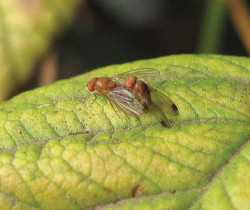SWD Rebounding In Pacific Northwest

Spotted wing drosophila, (SWD) a pest feared by growers of soft fruits such as cherries and berries, is being found in increasing numbers in the past few weeks in Pacific Northwest. Reports out of Washington and Oregon indicate that after a relatively quiet 2011, numbers are up this year because milder temperatures allowed it to overwinter.
Here is a report released Monday, June 25, by the Oregon Blueberry Commission, written by Vaughn Walton, a horticultural entomologist and associate professor at Oregon State University:
This will be the third growing season managing spotted wing drosophila (SWD), Drosophila suzukii, in Oregon small fruit and each year is different. We observed no problems with SWD the first year, 2010, probably because Oregon growers did not risk their crop and sprayed specifically for SWD. Last year, 2011, SWD was almost a no-show probably because of several cold snaps. This year, 2012, appears to be different from the previous two years because we are capturing more flies earlier and in more locations than in 2010 and 2011. This fact is being observed throughout the Pacific Northwest. We suspect the milder winter allowed more flies to successfully overwinter.
It appears that apple cider vinegar traps are not that effective in capturing flies from more than short distances. Relying on SWD counts from one or two traps may not be prudent. Place more traps, especially in hot-spot areas of your property and pay attention to the weekly SWD reporting put together by Wei Yang and Tom Peerbolt (spottedwing.com).
Research has indicated that protecting fruit from first color through harvest is critical and that the last two to three sprays before harvest are the most important. Research has demonstrated that the most effective SWD materials are OPs (diazinon, Imidan, and malathion), synthetic pyrethroids (Asana, Brigade, Danitol, and Mustang Max) and spinosad/spinetoram (Success-Entrust/Delegate). OPs and pyrethroids kill SWD faster than does Success, Entrust, or Delegate. Carbamates (Sevin and Lannate) are also effective materials. Research has demonstrated that neonicotinoids (Actara, Assail, and Provado) are not as effective as the OPs, synthetic pyrethroids, or carbamates against SWD. New lab studies are showing that female SWD treated with Pyganic (a pyrethrin product) can recover from an application and lay fertile eggs. Check pesticide tables to design a prudent control program (Link to tables) and be cognizant of Maximum Residue Levels (MRLs) if exporting to foreign markets.
If your fruit is beginning to show color, use effective SWD control materials. It is important to “zero-out” any flies that may be in your field using an application of an effective SWD material by ground when you target your first spray for SWD. Malathion ULV by air has been shown to be effective in cherries and may be an option for blueberries as a substitute for the first SWD spray.
Late harvested crops and cultivars are probably more at risk for SWD damage compared to early harvested crops because SWD populations will be greater later in the season. Be sure to protect your crop with effective insecticides against SWD. Contact your Extension agent or crop consultant regarding the most effective control for SWD in this critical period.









